EIA: CO2 emissions from US power sector have declined 28% since 2005
Green Car Congress
DECEMBER 24, 2018
US electric power sector CO 2 emissions have declined 28% since 2005 because of slower electricity demand growth and changes in the mix of fuels used to generate electricity, according to the US Energy Information Administration (EIA). Source: US EIA, US Energy-Related Carbon Dioxide Emissions , 2017.

















Let's personalize your content